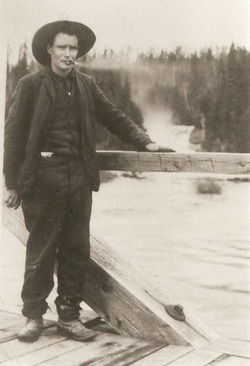
Thomas Surluga was born in Krizisce, Croatia in 1907. As a teenager he found himself bound for Northern Ontario and quickly mastered English and the use of a pick and shovel. Tom first came to the Wawa region to work on the completion of the new power plant at Michipicoten High Falls in 1930. In 1931 Tom took up prospecting with Cliff Miller for $2.50/day along the Catfish Creek and Black Trout Lake north of Wawa. Supplies were loaded in a canoe, poled up the currents of the Magpie River and portaged over a mile and a half. Though nothing substantial developed in this area, Tom had caught the prospecting bug.
From 1950 to 1960 Tom was drawn to the abandoned Michipicoten gold mines south of Wawa Lake. He staked and re-staked mining claims in the vicinity of the old Cora and Jubilee mine sites. On a hunch Tom re-staked his abandoned claim in September 1960 and 3 days later was negotiating its sale to Pango Gold. Surluga Gold Mine was formed in 1962. In 1966 at the age of 73, Tom drilled the first hole and helped celebrate in the excitement of the development of one of many gold mine operations in Wawa’s long mining history.
Between 1968 and 1969, over thirty thousand tonnes of rock were removed from the mine workings producing 2,300 oz of silver and 9,000 ounces of gold. The original Surluga Gold Mine operated as the Pango Gold Mines and Pursides Gold Mines Ltd from 1973 to 1980. It was last operated by Citadel Gold Mines Inc. from 1980 to 1999. The towering head frame was a constant site for Wawa residents scanning the forest topography along the south shore of Wawa Lake.
A gravel access road from Hwy 101 to the Surluga property was once a popular route called the Surluga Road. For Wawa residents, the name Surluga instantly conjures images of a meandering gravel road, abandoned headframes, rusted mining equipment and forgotten ghost towns. It was regularly travelled by local history buffs, grouse hunters, snowmobilers and those residents searching for any familiar sign of the numerous deserted mines and abandoned town sites that were once a part of the lucrative boom and bust mining economy of the 1900’s.
Unlike Tom, Joseph Ernest Aime Breton was a local boy to the core. Born in Sault Ste. Marie, Ontario in August 1907, Aime was raised in a large family whose parents were involved in the hotel industry. Aime loved the wilderness and people. He could run a hotel just as easily as he could trap, prospect, and entertain with his boxing prowess and famous one-man wrestling match.
During the Depression years, Aime found work at the Grace Gold Mine and the Wawa Gold Fields on the south shore of Wawa Lake. In 1935 he moved his wife Bea and family from Sault Ste. Marie to Wawa after purchasing the town’s only hotel, the Lakeview. When the hotel burned on Easter Weekend in 1944, the Breton’s rebuilt the current Lakeview, sold it to the Perkovich family and returned to Sault Ste. Marie to run the Central Hotel on Queen Street East.
Aime was always interested in mining and recognized the potential value of Northern Ontario’s vast undiscovered mineral resources. He is celebrated as playing a significant role in the initial discovery of the substantial uranium deposits between Blind River and Sudbury. The claims he staked in 1948 were later transformed into 12 uranium mines, 10,000 employees and the prosperous town of Elliot Lake in 1954. Aime’s prospecting ventures also resulted in the 1959 discovery of copper in a creek bed along Hwy 17 north of Sault Ste. Marie near Batchawana Bay which later became a mine operated by Tribag Mining Company.
In the spring of 1973 Wawa residents mourned the passing of Aime who lost his life on Lake Superior after his small fishing boat drifted off shore. As a result of this tragic incident, Ontario’s search and rescue protocol’s and policies were revamped and readjusted to provide local communities with stronger and more efficient channels of communication with various emergency response teams.
Aime Breton and Tom Surluga are just two of Algoma’s many colourful pioneers whose hard work, perseverance and dedication to family and community were the cornerstone of life in this unique corner of Northern Ontario.
 RSS Feed
RSS Feed
